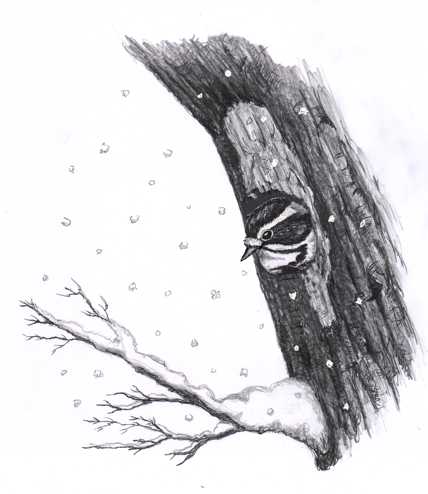
Dear Bird Folks:
Every fall we spend a few weeks camping at Sweetwater Forest in Brewster. This year we have been watching a Downy Woodpecker digging a hole in a tree, just above our heads. First we thought he was looking for bugs, but every day the hole becomes deeper and deeper. Finally the bird totally disappeared inside the tree, like he was building a nest. Isn’t fall an odd time for woodpeckers to be building a nest?
-Jamie, Durango, CO
Now Jamie,
Everybody knows that Sweetwater Forest is a fabulous place to camp, but do you really drive from the wilds of the Rocky Mountain state each year to go camping in Brewster? Really? I don’t get it. Next you’ll be telling me that you have a ski chateau in Chatham. Which of course is ridiculous, since we all know Chatham only allows residents to use any of its ski resorts.
Even though the politicians love to deny it, global warming has caused major environmental changes. However, it has not come to the point (yet) that the birds of New England are able to nest twelve months a year. All creatures must stop for the oncoming winter. Only humans never take a break from breeding. So, why is your woodpecker digging out a nest? Much like you Jamie, with your Chatham ski chateau, your Downy Woodpecker is only looking for a place to spend the winter.
Only about the size of a Twinkie, Downy Woodpeckers are North America’s smallest woodpecker. Yet they are hardy birds, living in the nasty heat of the deep south or the bitter cold of the far north, year round. Although there is some migration, most of their annual movement seems to be driven by food shortages rather than seasonal changes.
By learning carpentry skills at a very young age, Downy Woodpeckers have the ability to create a cozy place to live wherever they go. Whereas most birds search for a thicket to hunker down in during a cold night, downies dig out their own digs. Studies have shown that in colder climates woodpeckers will often build their roost cavities deeper into trees. They also make smaller entrance holes, that often face away from the prevailing winds, in order to conserve heat.
Yet, things don’t always go according to plan for these little woodpeckers. Winter storms love to knock over old dead trees, leaving them homeless. And sometimes unguarded holes are taken over by mice, squirrels or songbirds. A cold winter’s night is a bad time to be out looking for a new place to live. So downies usually excavate several roosting sites within their territory, just in case a storm trashes its main roost or squatters move in while they are out banging on trees.
Downies feed in flocks, but the flock rarely contains more than one or two other woodpeckers. Feeding with other woodpeckers would create too much competition. Usually they feed with other species of birds that require similar habitat, but with different foraging skills. Downy Woodpeckers are found in the company of chickadees, nuthatches, kinglets or titmice.
Hanging out with other birds offers them protection from predators. When you think about it, woodpeckers are easy targets because they are always eating with their backs to the open window. Huh? Well, you know, facing the trunk of a tree all day makes them extremely vulnerable to hawk attacks. They can’t see what’s behind them. Downies depend on the warning calls of the other songbirds in the flock to alert them to danger. More time searching for food and less time watching for danger will help them survive the short days and the long cold nights of winter.
No Jamie, there won’t be any breeding going on at your campsite this fall, at least not with that woodpecker. The bird that you saw digging out the tree was not trying to nest, just looking for a place to survive the winter. If you really are concerned about him, you could invite him to stay in your ski chateau in Chatham. However, he might have trouble finding it in all that fog.